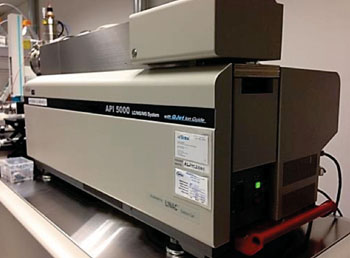Biomarkers Discovered For Chronic Kidney Disease Prognosis
By LabMedica International staff writers
Posted on 18 Aug 2016
Chronic kidney disease (CKD) is a critical health problem and CKD patients are highly prevalent throughout the world, and the number of end-stage kidney disease (ESKD) patients, who need to receive cost-prohibitive kidney replacement therapy, is increasing year by year.Posted on 18 Aug 2016
Currently, there is no effective method to predict the prognosis of chronic kidney disease (CKD) patients, but scientists have now found that measuring D-amino acids, which present only trace in human, provides prognostic information of CKD. D-amino acids, the enantiomers of L-amino acids, are increasingly recognized as potential biomarkers in several diseases.

Image: The API 5000 LC/MS/MS Detector System (Photo courtesy of AB Sciex).
Nephrologists at the Osaka University Graduate School of Medicine (Osaka, Japan) prospectively enrolled 118 consecutive patients with CKD stages 3, 4 and 5, who were not on dialysis, from a single nephrology department between August 2005 and January 2009. Baseline blood samples from patients after an overnight fast were collected into plastic tubes to prepare plasma.
The enantiomers of amino acids were quantified using the micro two-dimensional high performance liquid chromatography (2D-HPLC) platform. The 4-fluoro-7-nitro-2,1,3-benzoxadiazole (NBD)-derivatives of the amino acids were separated using a reversed-phase column (Shiseido, Tokyo, Japan). The retention time of NBD-amino acids were determined by authentic amino acid enantiomers, and the amounts were determined by the calibration lines. All the quantitative data were obtained by the fluorescence detection. In the second dimension, HPLC-mass spectrometry (MS/MS) was used to confirm the presence of D-amino acids in the real biological matrices. API-5000 and Triple Quad 5500 (AB Sciex, Framingham, MA, USA) were used as MS/MS instruments.
The scientists found that 16 out of 21 D-amino acids were detected in blood from CKD patients. Further analyses revealed that D-Serine and D-Asparagine were associated with the progression of CKD; the risk of progression to ESKD was elevated from two- to four- fold in those with higher levels of those D-amino acids. The authors concluded that their study will provided the novel method to the clinician which can identify CKD patients at high-risk for progression to ESKD. The information of D-amino acids would enable to select the best treatment for individual person, as well as the discovery of novel therapy.
This method is also applicable to such diseases as life style-associated diseases, such as diabetes mellitus and hypertension and cardiovascular diseases, as the prognoses of these diseases are strongly influenced by CKD progression. The study was published originally published online on May 18, 2016, in the journal Scientific Reports.
Related Links:
Osaka University Graduate School of Medicine
Shiseido
AB Sciex














